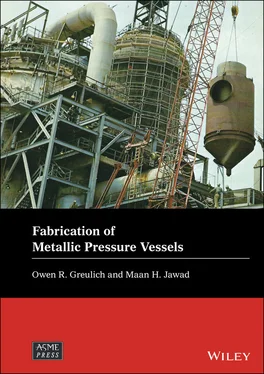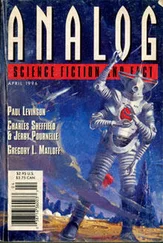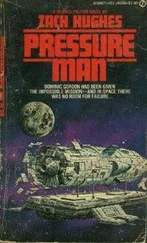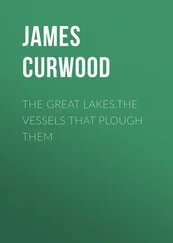Maan H. Jawad - Fabrication of Metallic Pressure Vessels
Здесь есть возможность читать онлайн «Maan H. Jawad - Fabrication of Metallic Pressure Vessels» — ознакомительный отрывок электронной книги совершенно бесплатно, а после прочтения отрывка купить полную версию. В некоторых случаях можно слушать аудио, скачать через торрент в формате fb2 и присутствует краткое содержание. Жанр: unrecognised, на английском языке. Описание произведения, (предисловие) а так же отзывы посетителей доступны на портале библиотеки ЛибКат.
- Название:Fabrication of Metallic Pressure Vessels
- Автор:
- Жанр:
- Год:неизвестен
- ISBN:нет данных
- Рейтинг книги:4 / 5. Голосов: 1
-
Избранное:Добавить в избранное
- Отзывы:
-
Ваша оценка:
- 80
- 1
- 2
- 3
- 4
- 5
Fabrication of Metallic Pressure Vessels: краткое содержание, описание и аннотация
Предлагаем к чтению аннотацию, описание, краткое содержание или предисловие (зависит от того, что написал сам автор книги «Fabrication of Metallic Pressure Vessels»). Если вы не нашли необходимую информацию о книге — напишите в комментариях, мы постараемся отыскать её.
A comprehensive guide to processes and topics in pressure vessel fabrication Fabrication of Metallic Pressure Vessels
Fabrication of Metallic Pressure Vessels
Fabrication of Metallic Pressure Vessels — читать онлайн ознакомительный отрывок
Ниже представлен текст книги, разбитый по страницам. Система сохранения места последней прочитанной страницы, позволяет с удобством читать онлайн бесплатно книгу «Fabrication of Metallic Pressure Vessels», без необходимости каждый раз заново искать на чём Вы остановились. Поставьте закладку, и сможете в любой момент перейти на страницу, на которой закончили чтение.
Интервал:
Закладка:
Table of Contents
1 Cover
2 Series Page
3 Title Page
4 Copyright Page
5 Dedication Page
6 Preface
7 Acknowledgments
8 1 Introduction1.1 Introduction 1.2 Fabrication Sequence 1.3 Cost Considerations 1.4 Fabrication of Nonnuclear Versus Nuclear Pressure Vessels 1.5 Units and Abbreviations 1.6 Summary
9 2 Materials of Construction2.1 Introduction 2.2 Ferrous Alloys 2.3 Nonferrous Alloys 2.4 Density of Some Ferrous and Nonferrous Alloys 2.5 Nonmetallic Vessels 2.6 Forms and Documentation 2.7 Miscellaneous Materials References
10 3 Layout3.1 Introduction 3.2 Applications 3.3 Tools and Their Use 3.4 Layout Basics 3.5 Material Thickness and Bending Allowance 3.6 Angles and Channels 3.7 Marking Conventions 3.8 Future of Plate Layout Reference
11 4 Material Forming4.1 Introduction 4.2 Brake Forming (Angles, Bump‐Forming) 4.3 Roll Forming (Shells, Reinforcing Pads, Pipe/Tube) 4.4 Tolerances Reference
12 5 Fabrication5.1 Introduction 5.2 Layout 5.3 Weld Preparation 5.4 Forming 5.5 Vessel Fit Up and Assembly 5.6 Welding 5.7 Correction of Distortion 5.8 Heat Treatment 5.9 Post‐fabrication Machining 5.10 Field Fabrication – Special Issues 5.11 Machining 5.12 Cold Springing
13 6 Cutting and Machining6.1 Introduction 6.2 Common Cutting Operations for Pressure Vessels 6.3 Cutting Processes 6.4 Common Machining Functions and Processes 6.5 Common Machining Functions for Pressure Vessels 6.6 Setup Issues 6.7 Material Removal Rates 6.8 Milling 6.9 Turning and Boring 6.10 Machining Centers 6.11 Drilling 6.12 Tapping 6.13 Water Jet Cutting 6.14 Laser Machining 6.15 Reaming 6.16 Electrical Discharge Machining, Plunge and Wire 6.17 Electrochemical Machining 6.18 Electron Beam Machining 6.19 Photochemical Machining 6.20 Ultrasonic Machining 6.21 Planing and Shaping 6.22 Broaching 6.23 3D Printing 6.24 Summary Reference
14 7 Welding7.1 Introduction 7.2 Weld Details and Symbols 7.3 Weld Processes 7.4 Weld Preheat and Interpass Temperature 7.5 Post Weld Heat Treating 7.6 Welding Procedures 7.7 Control of Residual Stress and Distortion 7.8 Material Handling to Facilitate Welding 7.9 Weld Repair 7.10 Brazing Reference
15 8 Welding Procedures and Post Weld Heat Treatment8.1 Introduction 8.2 Welding Procedures 8.3 Weld Preparation Special Requirements 8.4 Weld Joint Design and Process to Reduce Stress and Distortion 8.5 Weld Preheat and Interpass Temperature 8.6 Welder Versus Welding Operator 8.7 Weld Repair 8.8 Post Weld Heat Treating 8.9 Cladding, Overlay, and Loose Liners 8.10 Brazing Reference
16 9 Fabrication of Pressure Equipment Having Unique Characteristics9.1 Introduction 9.2 Heat Exchangers 9.3 Dimpled Jackets 9.4 Layered Vessels 9.5 Rectangular Vessels 9.6 Vessels with Refractory and Insulation 9.7 Vessel Supports 9.8 Summary References
17 10 Surface Finishes10.1 Introduction 10.2 Types of Surface Finishes Reference
18 11 Handling and Transportation11.1 Introduction 11.2 Handling of Vessels and Vessel Components Within the Fabrication Plant 11.3 Transportation of Standard Loads 11.4 Transportation of Heavy Vessels 11.5 Summary
19 12 ASME Code Compliance and Quality Control System12.1 Need for ASME Code Compliance 12.2 What the ASME Code Provides 12.3 Fabrication in Accordance with the ASME Code 12.4 ASME Code Stamping 12.5 Authorized Inspector and Authorized Inspection Agency 12.6 Quality Control System for Fabrication 12.7 Additional Stamps Required for Pressure Vessels 12.8 Non‐Code Jurisdictions 12.9 Temporary Shop Locations Reference
20 13 Repair of Existing Equipment13.1 Introduction 13.2 National Board Inspection Code, NBIC, NB‐23 13.3 ASME Post Construction Code, PCC‐2 13.4 API Pressure Vessel Inspection Code, API‐510 13.5 API 579/ASME FFS‐1 Fitness‐For‐Service Code 13.6 Miscellaneous Repairs References
21 Appendix A: Units and Conversion FactorsA.1 Some Customary Units A.2 Conversion Factors A.3 Length Conversions A.4 Miscellaneous Unit Conversions
22 Appendix B: Welding Symbols Reference
23 Appendix C: Weld Process CharacteristicsC.1 Weld Process Advantages and Disadvantages C.2 Weld Process Applications
24 Appendix D: Weld Deposition
25 Appendix E: Shape PropertiesE.1 Properties of Cross Sections E.2 Properties of Solids E.3 Properties of Hemispheres and Spherical Segments E.4 Properties of Commonly Used Ellipsoidal Heads E.5 Ellipsoidal Head General Formulas
26 Appendix F: Pipe and Tube Dimensions and Weights
27 Appendix G: Bending and Expanding of Pipes and Tubes G.1 TEMA Requirements for U‐Tube Thinning G.2 ASME B31 Code Requirements for Tube Thickness at U‐Bends G.3 Expansion of Tubes into Tubesheet Holes References
28 Appendix H: Dimensions of Some Commonly Used Bolts and Their Required Minimum Spacing
29 Appendix I: Shackles Reference
30 Appendix J: Shears, Moments, and Deflections of Beams Case 1. Simply supported beam – concentrated load at center Case 2. Simply supported beam – concentrated load at any point Case 3. Cantilever beam – concentrated load at free end Case 4. Cantilever beam – concentrated load at any point Case 5. Simply supported beam – uniformly distributed load Case 6. Cantilever beam – uniformly distributed load Case 7. Beam overhanging two supports‐uniformly distributed load
31 Appendix K: Commonly Used TerminologyK.1 Glossary K.2 Acronyms and Other Letter Designations
32 Index
33 End User License Agreement
List of Tables
1 Chapter 2 Table 2.1 Unified Numbering System (UNS) designations Table 2.2 Chemical composition of SA‐516 Grade 70 plates Table 2.3 Cost of various steels Table 2.4 Designation of aluminum with additional elements Table 2.5 Various tempers of aluminum Table 2.6 Levels of strain hardening Table 2.7 Level of thermal treatment Table 2.8 Copper alloy UNS numbering system Table 2.9 Hardness reductions in area Table 2.10 Temper designations Table 2.11 Annealed conditions Table 2.12 Some tempers by grain size Table 2.13 Some cold worked tempers Table 2.14 Some cold worked and stress relieved tempers Table 2.15 Some as‐manufactured tempers Table 2.16 Some heat treated tempers Table 2.17 Some specialized heat treated tempers Table 2.18 Some welded tube tempersTable 2.19 Some nickel alloy cross references and temperature limitsTable 2.20 Approximate cost of various nonferrous alloys compared to carbon...Table 2.21 Approximate density of various alloysTable 2.22 Sample material requisition form
2 Chapter 4Table 4.1 ASME‐1 [1] equations for calculating forming strainsTable 4.2 Brake forming loads
3 Chapter 7Table 7.1 Some welding comparisons
4 Chapter 8Table 8.1 Listing of essential, supplementary essential, and nonessential va...Table 8.2 Suggested form for welding procedure specifications (front) [1]Table 8.3 Groove‐Weld Tension Tests and Transverse‐Bend Tests [1]Table 8.4 Essential welding variables for welder performance [1]
5 Chapter 9Table 9.1 Differences between flanged‐and‐flued and bellows expansion joints
6 Chapter 10Table 10.1 Properties of some industrial coatings
7 Chapter 12Table 12.1 Manufacturer’s Data Report, U‐1 Form
8 Chapter 13Table 13.1 Comparison of some selected NDE methods
9 Appendix FTable F.1 Pipe propertiesTable F.2 Tube properties
10 Appendix ITable I.1 Sample Loads and Dimensions for Chain Shackles ( Source: Crosby Gen...Table I.2 Sample Loads and Dimensions for Anchor Shackles ( Source: Crosby Ge...Table I.3 Load Reduction Factors for Side‐Loaded Shackles with Size Up to 3 ...Table I.4 Load Reduction Factors for Side Loaded Shackles with Size Larger T...
List of Illustrations
1 Chapter 1 Figure 1.1 Outside machining of a hemispherical head Figure 1.2 A vessel fabricated with a heavy wall to minimize cost Figure 1.3 Side views of the vessel in Figure 1.2
Читать дальшеИнтервал:
Закладка:
Похожие книги на «Fabrication of Metallic Pressure Vessels»
Представляем Вашему вниманию похожие книги на «Fabrication of Metallic Pressure Vessels» списком для выбора. Мы отобрали схожую по названию и смыслу литературу в надежде предоставить читателям больше вариантов отыскать новые, интересные, ещё непрочитанные произведения.
Обсуждение, отзывы о книге «Fabrication of Metallic Pressure Vessels» и просто собственные мнения читателей. Оставьте ваши комментарии, напишите, что Вы думаете о произведении, его смысле или главных героях. Укажите что конкретно понравилось, а что нет, и почему Вы так считаете.











